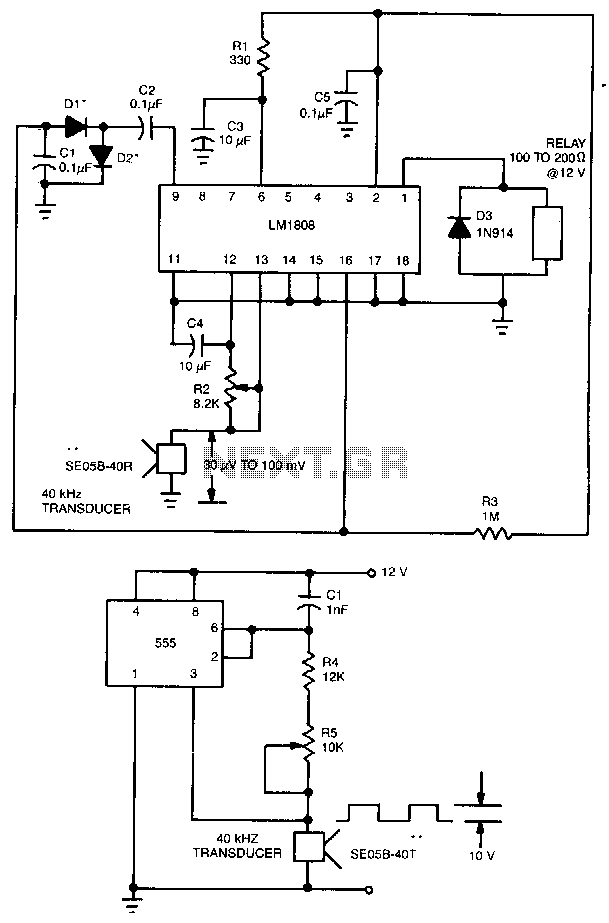
Ultrasonic-transceiver

This ultrasonic transmit/receive circuit operates at 40 kHz. Control resistor R5 adjusts the frequency for optimal performance with the transducers used.
The ultrasonic transmit/receive circuit designed to operate at a frequency of 40 kHz is essential for applications in distance measurement, object detection, and various industrial automation tasks. The circuit typically consists of a transmitter and a receiver, which work in tandem to emit and capture ultrasonic waves.
The transmitter section includes an oscillator that generates the 40 kHz signal, often implemented using a 555 timer IC or a microcontroller configured to produce a PWM signal. The output of the oscillator is fed into a driver circuit, which amplifies the signal to drive the ultrasonic transducer. The transducer converts the electrical signal into ultrasonic sound waves that propagate through the air.
The receiver section consists of a second transducer that detects the reflected ultrasonic waves. Upon receiving the echoes, the transducer converts the sound waves back into electrical signals. These signals are then processed by an amplifier and a comparator circuit to determine the distance of the object based on the time delay between transmission and reception.
Control resistor R5 plays a crucial role in fine-tuning the oscillator frequency to ensure optimal performance with the specific transducers employed in the circuit. The value of R5 can be adjusted to compensate for variations in transducer characteristics, environmental factors, or to match the resonance frequency of the transducer for improved sensitivity and range.
Additional components such as capacitors, diodes, and filters may be included to stabilize the circuit, reduce noise, and protect against voltage spikes. The design may also integrate a microcontroller for more advanced signal processing, allowing for features such as distance calculation, display output, and interfacing with other systems. Overall, the ultrasonic transmit/receive circuit is a versatile and effective solution for various sensing applications.This ultrasonic transmit/receive circuit operates at 40 kHz. Control resistor R5 adjusts the frequency for best performance with the transducers used.
The ultrasonic transmit/receive circuit designed to operate at a frequency of 40 kHz is essential for applications in distance measurement, object detection, and various industrial automation tasks. The circuit typically consists of a transmitter and a receiver, which work in tandem to emit and capture ultrasonic waves.
The transmitter section includes an oscillator that generates the 40 kHz signal, often implemented using a 555 timer IC or a microcontroller configured to produce a PWM signal. The output of the oscillator is fed into a driver circuit, which amplifies the signal to drive the ultrasonic transducer. The transducer converts the electrical signal into ultrasonic sound waves that propagate through the air.
The receiver section consists of a second transducer that detects the reflected ultrasonic waves. Upon receiving the echoes, the transducer converts the sound waves back into electrical signals. These signals are then processed by an amplifier and a comparator circuit to determine the distance of the object based on the time delay between transmission and reception.
Control resistor R5 plays a crucial role in fine-tuning the oscillator frequency to ensure optimal performance with the specific transducers employed in the circuit. The value of R5 can be adjusted to compensate for variations in transducer characteristics, environmental factors, or to match the resonance frequency of the transducer for improved sensitivity and range.
Additional components such as capacitors, diodes, and filters may be included to stabilize the circuit, reduce noise, and protect against voltage spikes. The design may also integrate a microcontroller for more advanced signal processing, allowing for features such as distance calculation, display output, and interfacing with other systems. Overall, the ultrasonic transmit/receive circuit is a versatile and effective solution for various sensing applications.This ultrasonic transmit/receive circuit operates at 40 kHz. Control resistor R5 adjusts the frequency for best performance with the transducers used.
